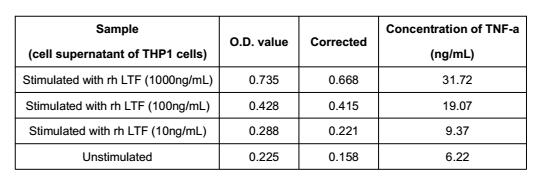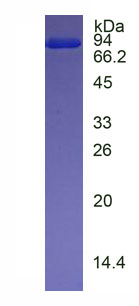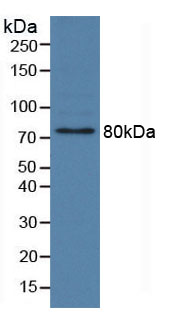Active Lactoferrin (LTF) 

HLF2; LF; GIG12; Lactotransferrin; Growth-inhibiting protein 12; Talalactoferrin; Lfcin-H; Kaliocin-1
- UOM
- FOB US$ 240.00 US$ 600.00 US$ 1,200.00 US$ 3,600.00 US$ 9,000.00
- Quantity
Overview
Properties
- Product No.APA780Hu01
- Organism SpeciesHomo sapiens (Human) Same name, Different species.
- ApplicationsCell culture; Activity Assays.
Research use only - DownloadInstruction Manual
- CategoryTumor immunityInfection immunity
- Buffer FormulationPBS, pH7.4, containing 0.01% SKL, 1mM DTT, 5% Trehalose and Proclin300.
- Traits Freeze-dried powder, Purity > 97%
- Isoelectric Pointn/a
Sign into your account
Share a new citation as an author
Upload your experimental result
Review

Contact us
Please fill in the blank.
Activity test

Lactoferrin (LF), also known as lactotransferrin (LTF), is a multifunctional protein of the transferrin family. Lactoferrin is one of the components of the immune system of the body; it has antimicrobial activity (bacteriocide, fungicide) and is part of the innate defense, mainly at mucoses. In particular, lactoferrin provides antibacterial activity to human infants. Lactoferrin interacts with DNA and RNA, polysaccharides and heparin, and shows some of its biological functions in complexes with these ligands. LTF is known to activate immune cells to produce several cytokines, such as tumor necrosis factor TNF-a, thus, a stimulation assay was conducted to detect the activity of LTF using human monocytic cell line THP-1. Briefly, THP-1 cells were seeded into wells of 24-well plates at a density of 5×106 cells/mL in RPMI-1640 with the addition of various concentrations of recombinant human LTF. After incubation for 20 hours, the concentration of TNF-a in the cell supernatant was detected using an ELISA kit. TNF-a levels in the cell supernatant of spleen cells increased significantly after stimulated with LTF, the data was shown in table 1.

Figure. TNF-a concentration in the cell supernatant of THP-1 cells up-regulated by LTF.
Usage
Reconstitute in 10mM PBS (pH7.4) to a concentration of 0.1-1.0 mg/mL. Do not vortex.
Storage
Avoid repeated freeze/thaw cycles. Store at 2-8°C for one month. Aliquot and store at -80°C for 12 months.
Stability
The thermal stability is described by the loss rate. The loss rate was determined by accelerated thermal degradation test, that is, incubate the protein at 37°C for 48h, and no obvious degradation and precipitation were observed. The loss rate is less than 5% within the expiration date under appropriate storage condition.
Increment services
-
 BCA Protein Quantification Kit
BCA Protein Quantification Kit
-
 Molecular Mass Marker for Protein
Molecular Mass Marker for Protein
-
 Monoclonal Antibody Customized Service
Monoclonal Antibody Customized Service
-
 Polyclonal Antibody Customized Service
Polyclonal Antibody Customized Service
-
 Protein Activity Test Experiment Service
Protein Activity Test Experiment Service
-
 Electrophoretic Mobility Shift Assay (EMSA) Experiment Service
Electrophoretic Mobility Shift Assay (EMSA) Experiment Service
-
 Buffer
Buffer
-
 Lentivirus Packaging Experiment Service
Lentivirus Packaging Experiment Service
-
 Adenovirus Packaging Experiment Service
Adenovirus Packaging Experiment Service
-
 Real Time PCR Experimental Service
Real Time PCR Experimental Service
-
 Spike RBD Protein (S-RBD)
Spike RBD Protein (S-RBD)
-
 Protein G
Protein G
-
 Protein A
Protein A
Citations
- Changes of hepatic lactoferrin gene expression in two mouse models of the acute phase reactionScienceDirect: S1357272511002524
- Changes in composition of colostrum of Egyptian buffaloes and Holstein cowsBioMed: 17466148
- p38MAPK, ERK and PI3K Signaling Pathways Are Involved in C5a-Primed Neutrophils for ANCA-Mediated Activation PlosOne: source
- Sphingolipid Pathway Regulates Innate Immune Responses at the Fetomaternal Interface during PregnancyPubmed:25505239
- Control of Methicillin-Resistant Staphylococcus aureus Pneumonia Utilizing TLR2 Agonist Pam3CSK4Pubmed:26974438
- Salivary lactoferrin is transferred into the brain via the sublingual routepubmed:28351211
- Effects of fluticasone propionate and budesonide on the expression of immune defense genes in bronchial epithelial cellsPubmed:29627483
- TLR2 agonist Pam3CSK4 enhances the antibacterial functions of GM-CSF induced neutrophils to methicillin-resistant Staphylococcus aureus
- Assessment of the Diagnostic Value of IL-10 and Lactoferrin by BIRADS Categories in Breast Neoplasms
- A Three-Protein Panel to Support the Diagnosis of Sepsis in ChildrenPubmed:35329889
- Three Urban of China: A Cohort Study of Maternal-Infant Factors and HM Protein ComponentsPubmed:35438093
- Myeloid-Specific Pyruvate-Kinase-Type-M2-Deficient Mice Are Resistant to Acute Lung InjuryPubmed:35625931








